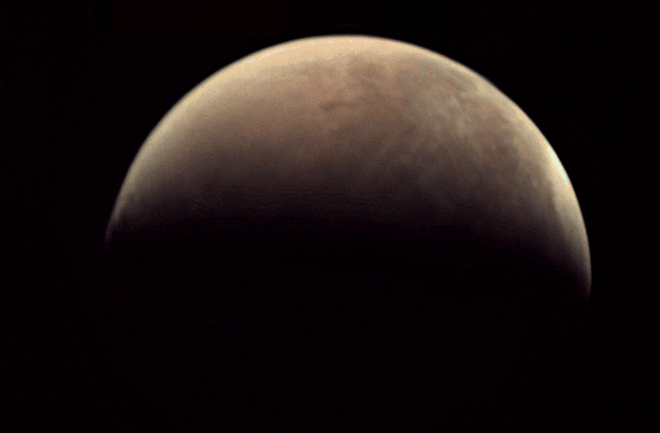On June 2, 2023, when the first livestream of Mars started, the red planet looked a bit like a blurry peanut butter cookie.
Every 48 seconds, a new image beamed from the humble Visual Monitoring Camera (VMC) attached to the Mars Express orbiter. Better described as a security camera than a scientific instrument, the VMC was originally attached to the probe to keep an eye on the detachable Beagle-2 lander (which went missing on Mars in 2003).
The VMC “was there for one reason,” Simon Wood, an engineer who works on Mars Express and one of the livestream’s panelists, said during the livestream.
First Livestream From Mars
After Beagle-2 and Mars Express parted ways, the flight control team turned off the camera and left it that way for several years. When they turned it back on a few years ago, they found the same fuzzy camera as before, but the images had charm. The team started posting them to the European Space Agency’s (ESA) social media as “The Mars Webcam.”
“It’s very much the type of camera you would have [bought at] PC World,” said Wood, “in the early 2000s.”
Read More: 50 Years Ago, a Forgotten Mission Landed on Mars
The Red Planet
ESA sent Express to Mars to investigate the presence of water there, and it found strong evidence of liquid water under the polar ice caps and photographed valleys carved by rushing water (using the vastly superior High Resolution Stereo Camera). Its other instruments include a star camera, equipped with star charts, that allows it to orient itself in space based on the positions of different stars.
Most of the images are fuzzy, but because Mars Express follows an elliptical orbit around the planet, it swings around close to it about three times an Earth day, allowing for much more dramatic pictures of the Martian surface.
Read More: Analysis of Mars Audio Reveals Different Rules for Sound on the Red Planet
Live Streaming a Planet
For the livestream, the craft flew pitched at just the right angle. This allowed the VMC to record the planet while the antenna could send the images back to Earth, approximately 190 million miles, or a 16-minute trip. So, the livestream wasn’t simultaneous, just as close to it as the speed of light (which governs the craft’s radio waves) would allow.
The stream marked the 20th anniversary of Express’ launch on June 2, 2003 with a two-year assignment. Thanks to some skillful handling, the probe has lasted 10 times that period and also got lucky a few times. The craft has some very real limits, including relying on aging lithium ion batteries, like those in an old cellphone.
The flight control team has tried to keep the batteries cold to prolong their lifespan, leading to some advice for phone owners.
“If you really want your mobile phone battery to last a long time, don’t discharge it more than 40 percent and keep it in the fridge at all times,” said Wood.
By the end of the stream, the Express was heading behind Mars, where the team would turn off many scientific instruments to conserve power and take it easy on the batteries.
Read More: Chasing Life on Mars

